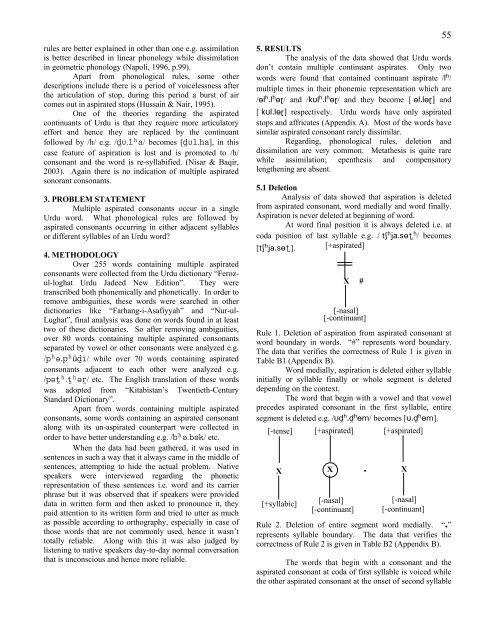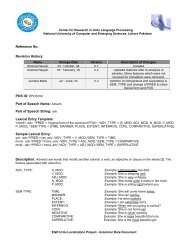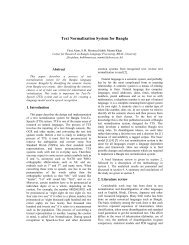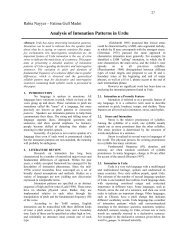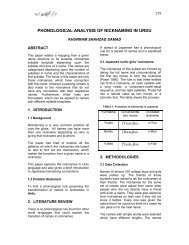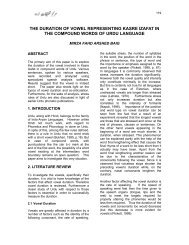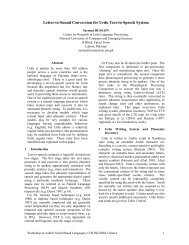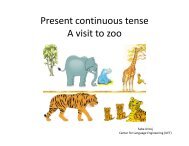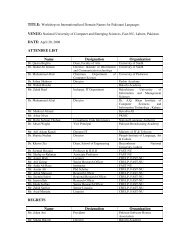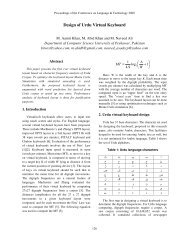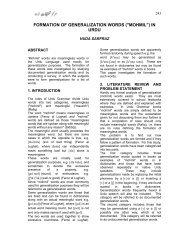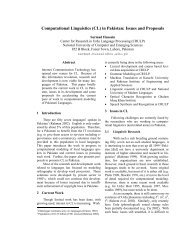Phonological Behavior of Multiple Aspirated Consonants in Urdu
Phonological Behavior of Multiple Aspirated Consonants in Urdu
Phonological Behavior of Multiple Aspirated Consonants in Urdu
Create successful ePaper yourself
Turn your PDF publications into a flip-book with our unique Google optimized e-Paper software.
ules are better expla<strong>in</strong>ed <strong>in</strong> other than one e.g. assimilationis better described <strong>in</strong> l<strong>in</strong>ear phonology while dissimilation<strong>in</strong> geometric phonology (Napoli, 1996, p.99).Apart from phonological rules, some otherdescriptions <strong>in</strong>clude there is a period <strong>of</strong> voicelessness afterthe articulation <strong>of</strong> stop, dur<strong>in</strong>g this period a burst <strong>of</strong> aircomes out <strong>in</strong> aspirated stops (Hussa<strong>in</strong> & Nair, 1995).One <strong>of</strong> the theories regard<strong>in</strong>g the aspiratedcont<strong>in</strong>uants <strong>of</strong> <strong>Urdu</strong> is that they require more articulatoryeffort and hence they are replaced by the cont<strong>in</strong>uantfollowed by /h/ e.g. /d.la/ becomes [dl.ha], <strong>in</strong> thiscase feature <strong>of</strong> aspiration is lost and is promoted to /h/consonant and the word is re-syllabified. (Nisar & Baqir,2003). Aga<strong>in</strong> there is no <strong>in</strong>dication <strong>of</strong> multiple aspiratedsonorant consonants.3. PROBLEM STATEMENT<strong>Multiple</strong> aspirated consonants occur <strong>in</strong> a s<strong>in</strong>gle<strong>Urdu</strong> word. What phonological rules are followed byaspirated consonants occurr<strong>in</strong>g <strong>in</strong> either adjacent syllablesor different syllables <strong>of</strong> an <strong>Urdu</strong> word?4. METHODOLOGYOver 255 words conta<strong>in</strong><strong>in</strong>g multiple aspiratedconsonants were collected from the <strong>Urdu</strong> dictionary “Ferozul-loghat<strong>Urdu</strong> Jadeed New Edition”. They weretranscribed both phonemically and phonetically. In order toremove ambiguities, these words were searched <strong>in</strong> otherdictionaries like “Farhang-i-Asafiyyah” and “Nur-ul-Lughat”, f<strong>in</strong>al analysis was done on words found <strong>in</strong> at leasttwo <strong>of</strong> these dictionaries. So after remov<strong>in</strong>g ambiguities,over 80 words conta<strong>in</strong><strong>in</strong>g multiple aspirated consonantsseparated by vowel or other consonants were analyzed e.g./p.pudi/ while over 70 words conta<strong>in</strong><strong>in</strong>g aspiratedconsonants adjacent to each other were analyzed e.g./pt.tr/ etc. The English translation <strong>of</strong> these wordswas adopted from “Kitabistan’s Twentieth-CenturyStandard Dictionary”.Apart from words conta<strong>in</strong><strong>in</strong>g multiple aspiratedconsonants, some words conta<strong>in</strong><strong>in</strong>g an aspirated consonantalong with its un-aspirated counterpart were collected <strong>in</strong>order to have better understand<strong>in</strong>g e.g. /b.bk/ etc.When the data had been gathered, it was used <strong>in</strong>sentences <strong>in</strong> such a way that it always came <strong>in</strong> the middle <strong>of</strong>sentences, attempt<strong>in</strong>g to hide the actual problem. Nativespeakers were <strong>in</strong>terviewed regard<strong>in</strong>g the phoneticrepresentation <strong>of</strong> these sentences i.e. word and its carrierphrase but it was observed that if speakers were provideddata <strong>in</strong> written form and then asked to pronounce it, theypaid attention to its written form and tried to utter as muchas possible accord<strong>in</strong>g to orthography, especially <strong>in</strong> case <strong>of</strong>those words that are not commonly used, hence it wasn’ttotally reliable. Along with this it was also judged bylisten<strong>in</strong>g to native speakers day-to-day normal conversationthat is unconscious and hence more reliable.555. RESULTSThe analysis <strong>of</strong> the data showed that <strong>Urdu</strong> wordsdon’t conta<strong>in</strong> multiple cont<strong>in</strong>uant aspirates. Only twowords were found that conta<strong>in</strong>ed cont<strong>in</strong>uant aspirate /l/multiple times <strong>in</strong> their phonemic representation which are/l.l/ and /kl.l/ and they become [ l.l] and[ kl.l] respectively. <strong>Urdu</strong> words have only aspiratedstops and affricates (Appendix A). Most <strong>of</strong> the words havesimilar aspirated consonant rarely dissimilar.Regard<strong>in</strong>g, phonological rules, deletion anddissimilation are very common. Metathesis is quite rarewhile assimilation; epenthesis and compensatorylengthen<strong>in</strong>g are absent.5.1 DeletionAnalysis <strong>of</strong> data showed that aspiration is deletedfrom aspirated consonant, word medially and word f<strong>in</strong>ally.Aspiration is never deleted at beg<strong>in</strong>n<strong>in</strong>g <strong>of</strong> word.At word f<strong>in</strong>al position it is always deleted i.e. atcoda position <strong>of</strong> last syllable e.g. / tja.s/ becomes[tja.s]. [+aspirated]Rule 1. Deletion <strong>of</strong> aspiration from aspirated consonant atword boundary <strong>in</strong> words. “#” represents word boundary.The data that verifies the correctness <strong>of</strong> Rule 1 is given <strong>in</strong>Table B1 (Appendix B).Word medially, aspiration is deleted either syllable<strong>in</strong>itially or syllable f<strong>in</strong>ally or whole segment is deleteddepend<strong>in</strong>g on the context.The word that beg<strong>in</strong> with a vowel and that vowelprecedes aspirated consonant <strong>in</strong> the first syllable, entiresegment is deleted e.g. /d.dm/ becomes [.dm].[-tense]X[+syllabic]X #[-nasal][-cont<strong>in</strong>uant][+aspirated]X[-nasal][-cont<strong>in</strong>uant][+aspirated]. X[-nasal][-cont<strong>in</strong>uant]Rule 2. Deletion <strong>of</strong> entire segment word medially. “.”represents syllable boundary. The data that verifies thecorrectness <strong>of</strong> Rule 2 is given <strong>in</strong> Table B2 (Appendix B).The words that beg<strong>in</strong> with a consonant and theaspirated consonant at coda <strong>of</strong> first syllable is voiced whilethe other aspirated consonant at the onset <strong>of</strong> second syllable


